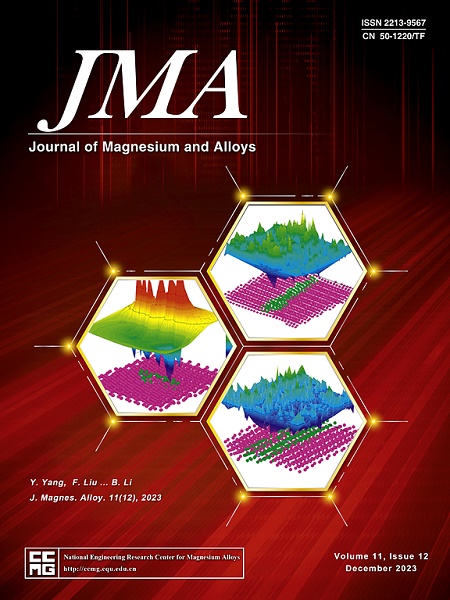Nanoscale analysis of interfacial structure and its effects on mechanical properties of Mg/Al laminate reinforced by TiB2 particles
IF 15.8
1区 材料科学
Q1 METALLURGY & METALLURGICAL ENGINEERING
引用次数: 0
Abstract
Fabricating Mg/Al laminate is an effective strategy to circumvent the inherently low formability and poor corrosion resistance of Mg alloys. Here, Mg/Al laminate with good bonding quality and mechanical properties was successfully fabricated via porthole die co-extrusion process using ZK60 Mg and TiB2/6061Al composite as constituted layers. Integrating the results from microstructural characterization and mechanical testing, the effects of extrusion temperature on microstructure, interfacial structure, element diffusion, and mechanical properties were investigated. The results show that Mg/Al laminate achieves a sound welding quality by mechanical bonding and diffusion bonding. The obvious intermetallic compounds (β and γ) layer forms at Mg/Al interface, and its thickness increases to 8.3 μm as the extrusion temperature reaches 400 °C. High extrusion temperature promotes the dynamic recrystallization and grain growth of Mg and Al layers, while the dislocation density decreases. β/γ interface shows a coherent feature, while γ/Mg interface is semi-coherent with a locally ordered transition zone of 4.5 nm. The rich Mg and Cr layers are found at TiB2/6061 interface, which is conducive to improving the bonding quality. When the extrusion temperature is 370 °C, the thickness of diffusion layer is around 5.0 μm, and the bonding strength reaches 18.68 MPa, resulting in the best comprehensive mechanical properties. This work provides a new direction for the development of Mg/Al laminate with excellent strength and ductility.
界面结构的纳米尺度分析及其对 TiB2 颗粒增强的镁/铝层压板机械性能的影响
制备Mg/Al层压板是克服镁合金固有的低成形性和耐蚀性差的有效策略。以ZK60 Mg和TiB2/6061Al复合材料为组成层,采用孔模共挤压法制备了具有良好结合质量和力学性能的Mg/Al层压板。结合微观组织表征和力学性能测试结果,研究了挤压温度对微观组织、界面结构、元素扩散和力学性能的影响。结果表明,通过机械连接和扩散连接,Mg/Al层合板获得了良好的焊接质量。在Mg/Al界面处形成明显的金属间化合物(β和γ)层,当挤压温度达到400℃时,其厚度增大到8.3 μm。高挤压温度促进Mg和Al层的动态再结晶和晶粒长大,位错密度降低。β/γ界面表现为相干特征,γ/Mg界面表现为半相干,局部有序过渡区为4.5 nm。TiB2/6061界面处存在丰富的Mg和Cr层,有利于提高结合质量。当挤压温度为370℃时,扩散层厚度约为5.0 μm,结合强度达到18.68 MPa,综合力学性能最佳。本工作为开发具有优良强度和延展性的镁铝复合材料提供了新的方向。
本文章由计算机程序翻译,如有差异,请以英文原文为准。
求助全文
约1分钟内获得全文
求助全文
来源期刊

Journal of Magnesium and Alloys
Engineering-Mechanics of Materials
CiteScore
20.20
自引率
14.80%
发文量
52
审稿时长
59 days
期刊介绍:
The Journal of Magnesium and Alloys serves as a global platform for both theoretical and experimental studies in magnesium science and engineering. It welcomes submissions investigating various scientific and engineering factors impacting the metallurgy, processing, microstructure, properties, and applications of magnesium and alloys. The journal covers all aspects of magnesium and alloy research, including raw materials, alloy casting, extrusion and deformation, corrosion and surface treatment, joining and machining, simulation and modeling, microstructure evolution and mechanical properties, new alloy development, magnesium-based composites, bio-materials and energy materials, applications, and recycling.
 求助内容:
求助内容: 应助结果提醒方式:
应助结果提醒方式:


